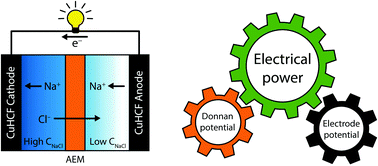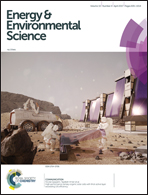High power densities created from salinity differences by combining electrode and Donnan potentials in a concentration flow cell†
Abstract
Recent estimates suggest that approximately 40% of global electricity demands can be met by capturing the potential energy contained in the mixing of seawater and freshwater at coasts. Several technologies are currently being explored to capture this energy and maximize the achievable electrical power density. Here we report a new method to capture this energy that yielded a peak power density of 12.6 ± 0.5 W m−2-membrane area (average = 3.8 ± 0.1 W m−2), which is the highest value reported to date for salinity gradient energy technologies fed with synthetic seawater (30 g L−1 NaCl) and freshwater (1 g L−1 NaCl). This unprecedentedly high power density was achieved in a concentration flow cell containing non-toxic copper hexacyanoferrate electrodes that developed electrode potentials based on Na+ activities and an anion-exchange membrane that developed a Donnan potential based on Cl− activities. The peak power density increased to 26.3 ± 1.3 W m−2 (average = 9.4 ± 0.9 W m−2) when using a highly saline synthetic brine (300 g L−1 NaCl) and freshwater (1 g L−1 NaCl). Stacking two flow cells in series doubled the total power while maintaining the same power per membrane area. Combining electrode and Donnan potentials in a concentration flow cell offers a new means to harvest salinity gradient energy that may lead to an economically viable technology.



 Please wait while we load your content...
Please wait while we load your content...